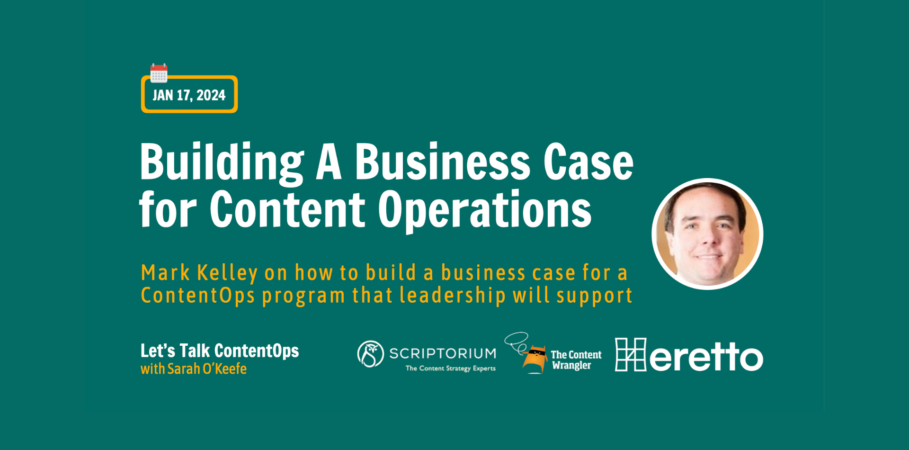Collaborate with a content strategist to transform content operations
Does any of this sound familiar?
- Content production is taking too long, delaying product launches, business expansion, and growth into global markets. Every minute of delay costs your company—big time.
- Short-term fixes have evolved into long-term problems, creating technical debt, process inefficiencies, and more.
- Your content team is running on “emergency mode.”
It’s time for a new way of managing content. Here’s how a content strategist can help you create successful content operations.
Can’t know what you don’t know
Whether you’re moving to a content management tool for the first time or replatforming content into a new system, it’s impossible to anticipate everything that could happen. And you shouldn’t have to!
There are a lot of bits and pieces that people just generally don’t think about because it’s not in their wheelhouse. They can’t know what they don’t know.
— Bill Swallow, Accelerate global growth with a content localization strategy
Most organizations make these transitions at specific points in their development, so chances are, you’ll only come to these crossroads a few times. Content strategists, however, navigate these projects all the time–they’re our bread, butter, and chocolate! (Because chocolate is essential.) We help you foresee potential obstacles, avoid common pitfalls, and create successful content operations.
One size fits no one
Every organization has unique needs and requirements.
It is not a one-size-fits-all situation with tools for content operations. Every organization’s requirements are going to be different. Those requirements are what should be driving your tool selection, not because you heard it at that conference.
– Alan Pringle, Confronting the horror of modernizing content
Customization is typically needed, but how much do you need? What standard elements can stay? Which tool is the best starting place? Also, many content management tools aren’t built to work together. Configuring integrations is possible, but often complex.
It’s common for different content departments within an organization to work independently. This separation limits your opportunities to reuse overlapping content, creates confusing duplicates and variants of information, and increases content production costs.
The answer lies in the company structure—your org chart. Techcomm, learning, and support departments nearly always report to different executives, and each executive is appropriately focused on their department’s priorities. Each department optimizes content operations for their own requirements and sharing across departments isn’t a priority. […] We need to build out content operations so that we can identify shared content, write it once, and share it across the organization.
– Sarah O’Keefe, The reality of enterprise customer content
How to hire the right people
No matter which content strategist you choose, we recommend finding an expert with these characteristics.
Collaboration with in-house expertise
A content strategist doesn’t replace your in-house expertise. Your team has invaluable domain knowledge while our team members are experts in content strategy, tools, and configuration. Combining those perspectives is the key to creating successful content operations.
We managed to cleanly transfer over what this client had with a decent output. We worked with them a lot because it was so different from what they had, but in the end, they ended up with a really good model. Their developer is just awesome!
– Melissa Kershes, Your tech expertise + our CCMS knowledge = replatforming success
For collaboration to be effective, it’s critical to build trust through transparent communication, setting upfront and honest expectations, and consistent communication.
When things didn’t exactly go according to plan, because you always run into that with a migration, the client could always see our work and know exactly where that time went. That level of transparency was something that I believe contributed to them doing more phases with us.
– Gretyl Kinsey, Your tech expertise + our CCMS knowledge = replatforming success
Training mindset
A content strategist should prepare your team to be comfortable navigating their authoring environment and publishing processes.
We hit a turning point where the bulk of the work they needed us to guide them through passed. Instead, they began to identify other priorities that we could help with.
– Gretyl Kinsey, Your tech expertise + our CCMS knowledge = replatforming success
Find a content strategist who prioritizes your team’s independence and long-term success through effective training and knowledge transfer.
Content therapist
As an external third-party observer, content strategists can see and say things to bring about the change your team needs. We’re skilled at communicating the business value of technical concepts, showing how content operations support organizational success.
Years ago, we had a client refer to us as content therapists. There are a lot of parallels there, because when we come in, we get to talk to you, and you get to offload all of your complaints onto us. We take that on board, discuss it with you, and figure out some ways to improve things. Then, hopefully magic will happen.
– Alan Pringle
I also want to say think of them as a marriage counselor, too. They’re that outside voice that can say, “Now I realize this is uncomfortable, but you’re shooting yourself in the foot. You’re doing too much work, no-bang-for-your-buck,” kind of thing.
– Janet Zarecor, Confronting the horror of modernizing content
Building successful content operations
Before moving forward with tool selection, configuration, or anything else, it’s essential to start with a content strategy. This is the framework for ensuring your content supports your organizational goals.
With a plan in place, whether it’s a full assessment or fragmented based on your in-house expertise, we help you decide which tools are the right fit for you and how they need to be configured and/or integrated. Then, if you choose, we can help you build that system.
Successful content operations futureproof your content so that unforeseen obstacles–industry disruptions, business setbacks, and so on–don’t catapult you into chaos. Single sourcing is a key aspect of futureproofing your content. By creating a single source of truth for your content, you can efficiently manage content by creating it once, storing it in a single repository, and referencing it across multiple platforms. This helps you maintain consistency and makes it easier to implement information updates.
ROI for successful content operations
This is what you can expect from successful content operations:
- Scalable content processes. Rather than waiting until a product launch goes awry or business expansion gets delayed to fix processes, successful content operations ensure that your content is ready to grow when you are.
- Localization. Whether you’re currently moving products and services into new markets or you’d like to expand in the future, successful content operations prepare you for global growth.
- Consistency. Through single sourcing, you can maintain a universal brand voice and maintain accurate, consistent, and updated content at scale.
- Reduced content production costs. By eliminating manual formatting and leveraging content reuse, you can significantly reduce the hidden costs of creating content. Our content operations ROI calculator can give you a savings estimate.
During a replatforming project with the Financial Accounting Foundation (FAF), a content team was set up for success with futureproof content operations.
We built an end-to-end process where we are able to produce both the document and an update to our codification from a single source of content. That was a big and exciting win. Our key takeaway was that this process has to start with knowing your organization and what makes you unique. That way, you can be very clear with your team about your scope and protect it, which is very hard to do on a long-term project like this. It’s a technology project obviously, but a lot of it is a very human process and it’s as good as the people you get in the room and the collaboration and forward thinking that you get from the team.
— Emilie Herman, Replatforming an early DITA implementation





